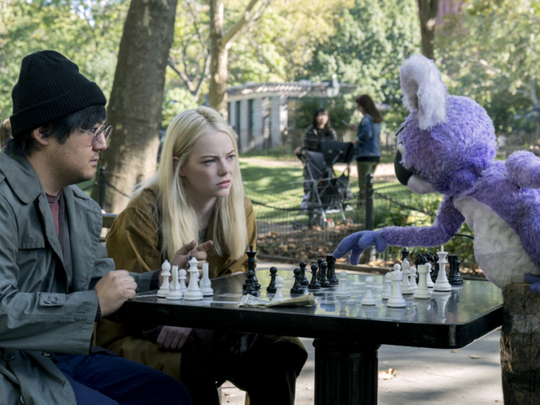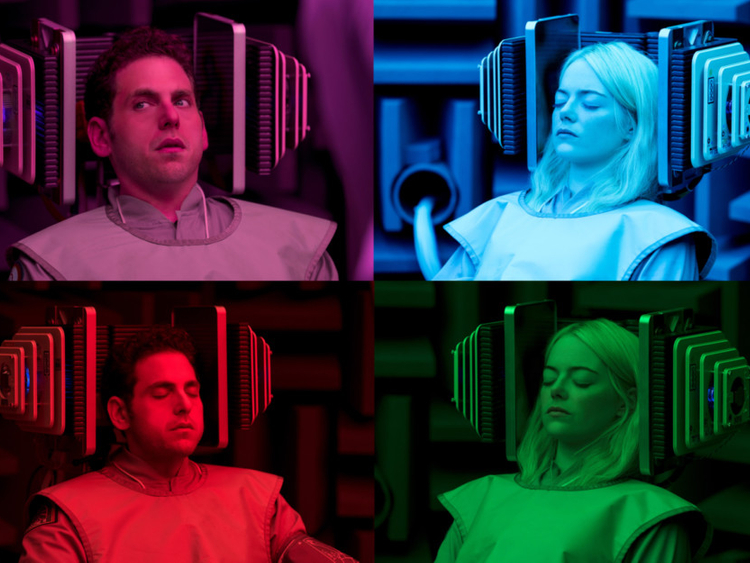
Last fall, actress Emma Stone, wraith pale and peroxided, sat in a folding chair on a Silvercup Studios soundstage in Queens. She wore a tank top and gray coveralls. Her face, fluorescent-lit, was set in perma-scowl.
“What’s normal, anyway?” she asked the camera throatily.
Good question.
Stone, in her first major television role, plays a damaged young woman named Annie in Maniac, a half-hour limited series, which begins streaming on Netflix on Friday, and (really) likes to keep its viewers off-kilter. Just when you’ve found your balance, the rug zooms out from under again. And wait: Where did those elves come from? This is a show with side effects.
“It was kind of important to us that there is no normal,” said the director Cary Fukunaga (True Detective, Beasts of No Nation), who developed the series with Patrick Somerville, a novelist and a writer and producer of The Leftovers.
Maniac is based, as loosely as a snapped balloon string, on a sweetly absurdist Norwegian series with the same name. The original Maniac, set in a mental hospital, centers on Espen, a schlubby inmate and likely schizophrenic who repurposes his bland surroundings for an active fantasy life in which he imagines himself as a cowboy, a war hero, a superspy.
When the producer Michael Sugar bought the rights to the series, he offered it to Fukunaga, who took it because, “I wanted to do something that allowed me to play around with different genres,” he said. (A few of those genres: caper, thriller, fantasy.) He brought on Somerville and they scrapped just about everything — setting, characters, tone.
In place of an asylum, they’ve substituted a clinical drug trial. And Espen has morphed into two characters, Stone’s Annie, a depressive and drug addict grieving a family trauma, and Jonah Hill’s Owen, a man estranged from his wealthy clan and a possible schizophrenic. Under the dubious supervision of the toupeed Dr. Mantleray (Justin Theroux) of Neberdine Pharmaceuticals and Biotech, participants test a sequence of pills designed to cure any mental illness and “eradicate all unnecessary, inefficient forms of human pain forever.” Results may vary.
The pills, and some “powerful microwave technology,” shunt the participants into dreamlike states where they encounter past traumas and current coping mechanisms. (Is it all in their heads? Probably.) Annie and Owen, whose psyches have become mysteriously linked, suddenly find themselves as Long Island high school sweethearts or a pair of ritzy 1940s grifters. And yes, in one sequence Stone plays Annie as an elf.
The tone mutates, too, swerving from light to dark, gentle to cruel, loopily surreal to bluntly aggressive, sometimes in a single episode. Even the scenes set in the supposedly ordinary waking life are meant to make you feel messed up.
Maniac conjures a day-to-day world in which technological advances topped out sometime in the 1970s and society has fractured. The microprocessor never happened; smartphones don’t exist. New drugs flood the market, cybersex has taken some odd turns and — just to put the psycho firmly back in psychodrama — there’s at least one purple koala playing chess in Washington Square Park.
The characters don’t feel comfortable in everyday life. Neither should the audience.
“I want the audience to feel slightly disoriented about what reality is,” said Somerville, speaking by telephone. “I think that’s cool.”
“Reality is weird!” he added.
Reality seemed fairly stable - if also fairly hectic - on set last fall. Filming was a little more than half completed and everyone was about to take a short break, which explained the cake frosted to read, “Hiatus Time, Let’s Party.” The rooms housing the drug trial glowed eerily and variously caffeinated assistants rushed around, preparing the set and the actors for an upcoming scene.
“Those scars look so real,” Hill said as he passed Stone. (They met in 2007’s Superbad and have remained close ever since; complimenting each other on creepy makeup is pretty much routine.)
Maniac was filmed over four months, which isn’t an absurdly small amount of time for a 10-episode series, but a snug fit when only one director, especially a director as meticulous as Fukunaga, is overseeing every episode. Even the first season of True Detective, which Fukunaga also directed in its entirety, had only eight episodes. And it didn’t depend on “a globular cluster of arborised realities,” Neberdine-speak for a branching system of distinct but not entirely separate worlds.
“For what we were trying to accomplish, we had a pretty low budget” - Netflix wouldn’t reveal what that budget was - “and a nearly impossible sort of schedule,” Fukunaga said.
At Silvercup, during a break between scenes, the production designer, Alex DiGerlando, summoned Fukunaga, who’d grown a mid-shoot near-beard and seemed to be surviving mostly on almonds and herbal tinctures, to a table where he’d assembled an assortment of rusty medieval weaponry: an ax, a halberd, some vicious hooked knives and more. Fukunaga nixed everything. It was too unspecific, too boring. The elves and half-elves deserved better.
The globular cluster of arborised realities wasn’t only a hassle for the props department, it was also a strain on the actors involved. Many of the cast members reappear as multiple characters. And some of the characters seem aware that they’re not entirely real. When Stone plays Arlie, the Gold Coast con artist, she also has to play moments in which Annie scrapes through Arlie’s brilliantined exterior and then other moments in which the two characters seem to merge.
That wasn’t too hard for Stone. “Obviously, I thought, ‘How the hell am I going to play five characters and switch in and out of them on a day-by-day basis,’” she said, “but it was really kind of a joy.”
When it came to the moments where Annie bled through, it reminded her of all the moments in other projects when she’d let her own life, her own emotions surface for an instant before letting the character take over again.
The other challenge, maybe the hardest challenge, was to make a series this weird, this wonky, this full of koalas and a cappella and chunky computer graphics, that also respected what Owen and Annie are suffering, the ways in which her PTSD and his schizophrenia are crippling their lives. Even in a series where reality is up for grabs, that had to feel real. Their pain is never the punch line.
__
Don’t miss it
Maniac streams on Netflix from September 21.
















